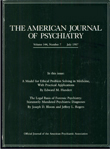Blind, controlled, long-term study of the comparative incidence of treatment-emergent tardive dyskinesia with olanzapine or haloperidol
Abstract
OBJECTIVE: Tardive dyskinesia is a serious and common complication of neuroleptic treatment. Olanzapine is a novel antipsychotic agent exhibiting regional mesolimbic dopaminergic selectivity and a broad- based pharmacology encompassing serotonin, dopamine, muscarinic, and adrenergic receptor binding affinities. The authors' goal was to compare the incidence of tardive dyskinesia among patients receiving olanzapine and those receiving the conventional dopamine 2 antagonist haloperidol. METHOD: Data were analyzed from three actively controlled and blind long-term responder studies of subjects meeting DSM-III-R criteria for schizophrenia, schizophreniform disorder, or schizoaffective disorder treated with olanzapine (N = 707, up to 20 mg/day, 237 median days of exposure) or haloperidol (N = 197, up to 20 mg/day, 203 median days of exposure) who did not have evidence of tardive dyskinesia at baseline. All of the subjects had a chronic disease course (mean greater than 10 years), and there were no significant between-treatment group differences in demographic or disease characteristics. The Abnormal Involuntary Movement Scale and research diagnostic criteria for tardive dyskinesia were used to define the comparative incidence rates of long-term treatment-emergent tardive dyskinesia. RESULTS: The incidence of newly emergent tardive dyskinesia at any visit after baseline, at the final visit, and at the final two clinical assessments was statistically significantly lower among olanzapine-treated patients than among haloperidol-treated patients. CONCLUSIONS: These findings support an atypical extrapyramidal symptom profile and the potential of a significantly lower risk of tardive dyskinesia with olanzapine than with haloperidol among patients requiring maintenance antipsychotic treatment.



